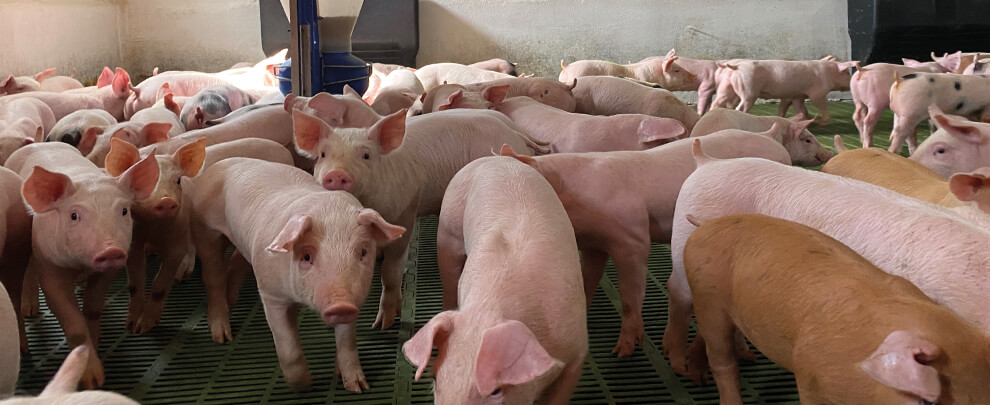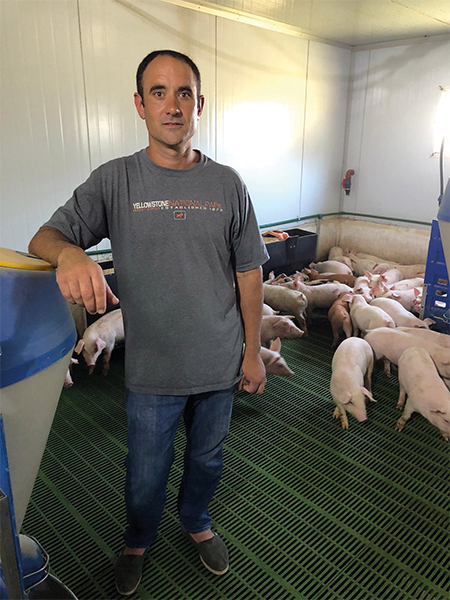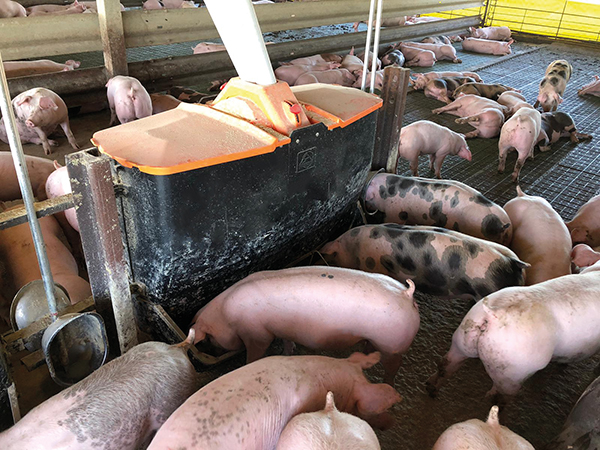Blog
Blog

M. Rostán: “Rotecna offers efficient and long-lasting solutions”
08th January 2025 - Success stories
Since Martín Rostán discovered Rotecna solutions, he has gradually integrated them into the Agrolake farm in Palmitas, Uruguay. It currently has the Feeding Ball, heated plates, different models of feeders, slats, etc. Thanks to these products, he has optimised feeding his animals and improved their welfare. Rostan breaks down the benefits achieved and explains where the pork sector is in Uruguay.

Martín Rostán in one of the weaning pens. Photo: M.R.
When did you decide to commit yourself to livestock?
I was always interested in veterinary medicine, and 14 years ago, I started as a veterinarian in charge of this farm. When I first started, the former owner gave me the possibility of buying capital from it little by little, and since 2023, I have achieved 100% ownership.
How is the farm distributed?
The facilities have five warehouses: males, gestation, maternity, weaning and fattening. We have Rotecna equipment in all of them.
How many people work in them?
We are currently three people: one in charge of gestation, maternity and weaning; another in charge of fattening; and me, who works everywhere. I oversee the rest of the farm’s activities, administrative management, purchasing, sales, etc. Being on a small farm, this part can be challenging.
In the maternity wards, the Rotecna Feeding Ball is used. Why did you go for it?
We worked with individual feeding for four years, and finding the right feed point was challenging. We tried to give the sows as much food as they wanted but avoided wasting feed due to excess. It is a very artisanal task and impossible to achieve daily. One day, I saw some videos about the Feeding Ball, and how it worked convinced me so much that I decided to install them in all the maternity wards. It is a very simple dispenser that anyone can use and allows a quick and effective reading of the females who are eating well and those who, on the contrary, eat little. In my case, I have them installed with the manual hopper.
In maternity, you also have electric heated plates. What advantages do you highlight?
The plates are efficient and safe and have a very low energy consumption, which does not significantly impact the energy bill. To regulate them effectively, we rely on the observation of the piglets: that is, if we see that they avoid the plate, we lower the intensity, and when we know that they are piled up on them, we increase it. Because of their advantages, we also have them installed at weaning.
What other Rotecna solutions do you have for weaning?
Weaning is 100% equipped with Rotecna products. Since implementing them, I have confidence in the brand, as it offers efficient and long-lasting solutions that optimise feeding and improve well-being. We have the slats, the PVC profiles to separate the pens, and the heated plates, which we have created a comfort zone where the piglets can sleep. In addition, we installed the TR4 hopper and the Swing R3 Duo, to which the animals adapt very quickly, and the Easy Drinker Mini drinkers, which provide clean water and minimise waste compared to traditional pacifiers.

The TR3D offers good results in conversion rate. Photo: M.R.
You also have one of our large capacity feeders for fattening, the TR3D. Why did you choose this option?
The pork industry advances quickly, and knowing that Rotecna always seeks to innovate, I was convinced by the advantages I saw in the TR3D. I assumed that they would adapt to my system very well. We have only had them for three months, but we are already seeing excellent indicators in terms of the improvement in the conversion rate. Something no less important is the ease of handling since its ten adjustment points allow you to find the best point for each batch and the loading comfort, which we can do straightforwardly due to its height.
What are your main health concerns?
As a veterinarian, I have little work to do on my farm, as it is very stable in terms of health. I only incorporate liquid genetics from Spain to renew the lines.
What biosecurity measures do you have on your farm?
Outsiders are prohibited from entering; we do not feature live animals, only semen. In this way, we renew genetics and maintain a more stable health status.
Finally, what is your vision of the pork sector in Uruguay?
Uruguay has significant advantages for pig farming, thanks to its large production of raw materials such as corn and soybeans. In addition, the country is recognised worldwide for the quality of its beef and the confidence in its exporting companies. Beef export channels, which are very active, could also be used for pork. However, we currently need the technical means to export it, which limits this option in the short term, although it is possible. On the other hand, in the domestic market, pork consumption is high, reaching approximately 20 kg per person per year, above the consumption of chicken meat but still below beef, which exceeds 40 kg. Of those 20 kg of pork, 85% corresponds to imports. Although replacing this imported meat with local production of higher quality is a challenge, it represents a great opportunity since the demand already exists. To conquer the market that imported meat has today, more than the individual effort of the producers is needed. The support of the entire production chain and State policies that promote and make pig production attractive in Uruguay are necessary.






